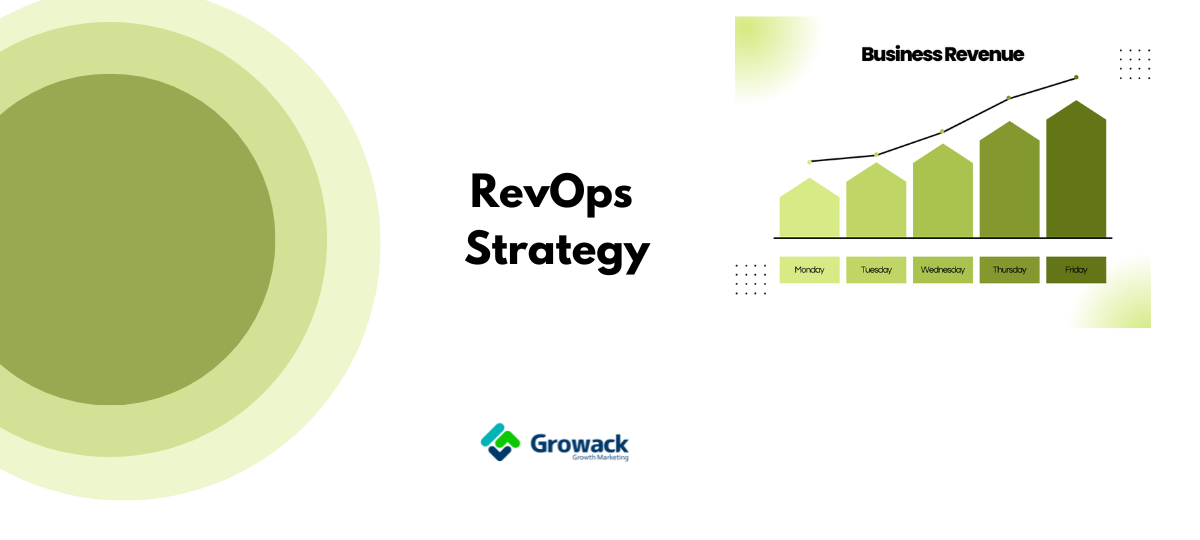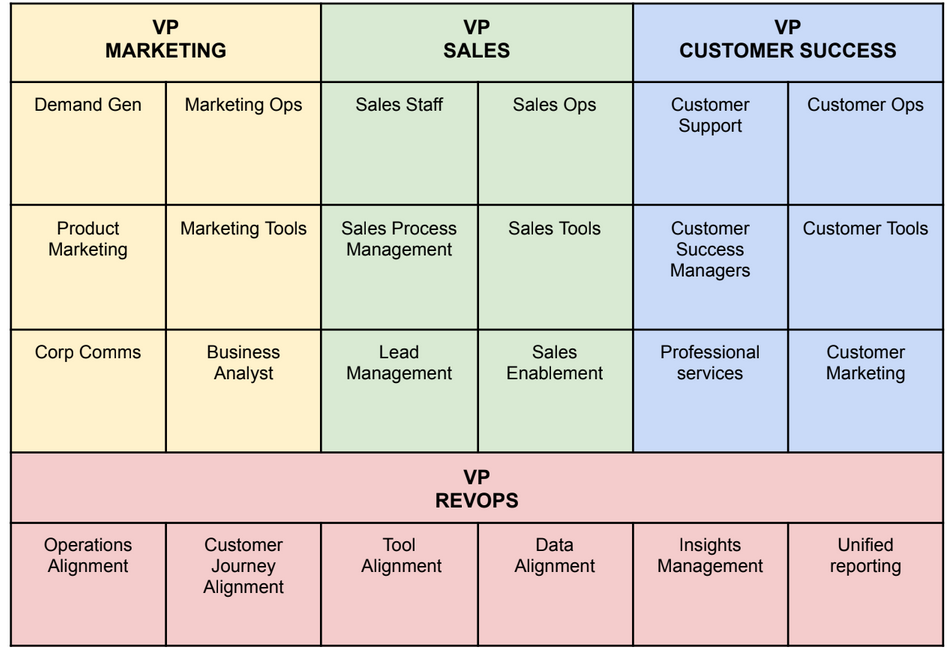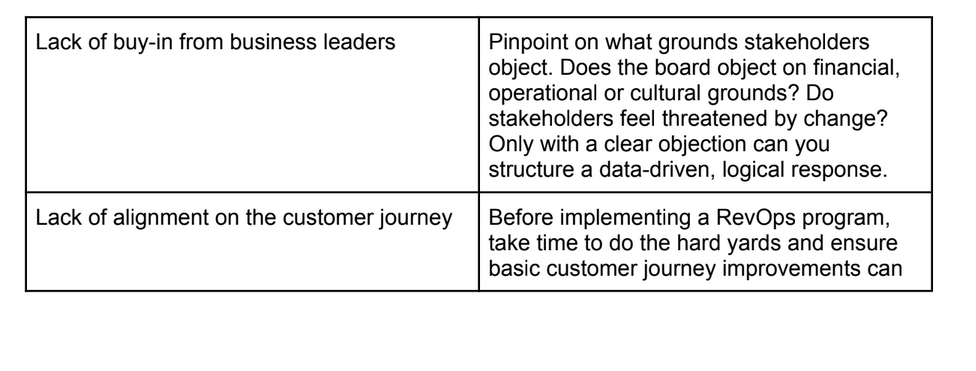
Getting Started with Revenue Operations(RevOps)
RevOps Strategy
1. What is RevOps?
Revenue operations (RevOps) align Marketing, Sales, and Customer Success functions to foster better revenue growth by connecting technology, processes, and strategy.
Traditionally, businesses operate as disparate departments, each with its own goals and tools, leading to friction points and lost sales conversions.
RevOps addresses these challenges by improving collaboration and visibility across teams. This unifies the organization through shared goals and information, driving operational efficiency and cohesion. Much like an orchestral conductor, RevOps harmonizes different functions to create a powerful, unified result.
Achieving this requires a thorough examination of the business, focusing on strengths and weaknesses. While challenging, the improved financial outcomes make the effort worthwhile.
2. Growth of RevOps in businesses
Since 2019, there’s been a 300% increase in RevOps-related roles on LinkedIn and a 57% increase in companies implementing RevOps strategies or building RevOps teams.
According to a recent HubSpot blog, companies that implement RevOps have seen the following impact:
● 10-20% increase in sales productivity
● 15% increase in profitability
● 19% increase in speed of growth
● 71% improvement in stock performance
● 100-200% increase in digital marketing ROI
Impressive, right?
But what if the system is working well and delivering the results we hear you say?
Well, if it ain’t broke, don’t fix it. Right?
Not quite.
According to HubSpot, 60% of current operations professionals end up repeating or double handling business tasks due to a lack of team alignment. This means targets get missed, goals aren’t reached and stakeholders across the board get frustrated. It’s a lose/lose for everybody.
But once you get the orchestra all playing the same song, your business will thrive.
3. The origin of RevOps: 6 ways SaaS has changed relationships between customer and business
In most business deals, the greatest revenue is often achieved after the point of sale. I.e., delighting customers through a range of appropriate cross-selling, up-selling and re-selling opportunities after the initial conversion.
To provide this type of customer-first experience, you’ll need to spend some cash upfront. But, the money you’ll likely spend to secure a customer (or the cost of acquisition) is only a small fraction of what you can expect to earn from them over the course of their customer lifecycle.
Once you recognise and accept this shift in customer focus, you’ll be able to shift your energy towards fostering customer loyalty and driving more revenue. These are the 6 main ways SaaS has altered relationships between customers and the businesses they buy from:
- Most revenue is achieved after the point-of-sale
- Traditional funnels are dead, and now customer journeys are non-linear
- Customers now have thousands of options at their fingertips
- Customers now consistently demand a more personal, frictionless experience
- There are typically more stakeholders involved in a purchase decision
- The rate of change is ever increasing
4. How to break down silos for go-to-market teams
Before RevOps
Historically, most organisations separate their Marketing, Sales and Customer Success departments as per the diagram above. But as you can see, this often leads to siloed data sets, tech stacks and processes. And the issue isn’t just the siloing of data. It also creates at least three clear friction points for the customer as they pass from one function to the other as they move through the sales process.

Now let’s explore the same journey from a RevOps position:
After Revops

As you can see, once RevOps is at play in the go-to-market arm of a business, it’s easier to recognise sales, marketing, and customer success as a single function with a clear alignment between data, technology, and processes.
Now let’s see how Marketing, Sales & Customer Service can be better connected through RevOps.
REVOPS MODEL

It’s important to note RevOps doesn’t sit above or below the existing VPs of Sales,
Marketing or Customer Success. The role acts as a unifying entity to ensure the tools and processes of each are best aligned for maximum results.
By having an overview of all depts, RevOps can spot and fix the numerous friction and drop-off points that siloed growth functions often have.
5. The 5 main benefits of RevOps

In short, think of these benefits as:
● Making better decisions faster
● Getting the right data in hand to make those decisions
● Building trust and predictable pipeline
But selling a fresh idea as bold as RevOps to sceptical colleagues or a resistant board isn’t easy. Change can be hard work and a ‘No’ is always easier to get than a ‘Yes’ when it comes to asking for extra budgets for fundamental business change.
With is in mind, there are two key points you should try and remember to communicate when approaching your go-to-market teams with the idea of RevOps:
1. How having a codified, replicable process will help deals close faster
2. How RevOps will help the organisation build a consistent approach to scaling
6. 6 pillars of RevOps
If you take anything from this guide, let it be the following pillars:


7. Key performance indicators (KPIs) for RevOps
There are several key performance indicators (KPIs) to pay attention to when it comes to RevOps. When you’re building out your RevOps function, the three main things to evaluate are:
- Customer churn
- Revenue per employee
- Account relationship score
Useful areas for RevOps to measure:


As should hopefully be clear, RevOps is about maximising the efficiency of your Marketing Sales and Customer Service functions by better aligning tools and processes to reduce conversion friction and delight the customer at every stage. Without getting into too much detail, each of the indicators above tells a story about your customer journey. They’re all data points with which a savvy RevOps practitioner can better understand how to improve the customer journey and reduce friction.
- Pipeline velocity too slow? You might need to reduce friction in your quote send and sign off process
- Poor renewal rate? Customer Success may need to share upsell data with Sales earlier in the process
- NPS score low? Maybe customers need delighting earlier in the sales process
Of course, these are only three example suggestions but they highlight how data points are more than numerical information; they’re insights into where the customer journey can be improved by better aligning how a business interacts with a customer.
8. How to build a revenue machine with HubSpot

i) Align teams & map the customer journey
Before a lead even enters your CRM, it’s important to condition all three departments (Marketing / Sales / Customer Service) so they fully understand how and why a RevOps approach works.
By knowing exactly where, when and how customer handovers will occur and intersect as the prospect moves through your sales cycle, you can reduce friction, speed up onboarding and ensure the customer’s, not the organisation’s needs, are the number one priority at all times.
ii) Map the customer journey and Ideal Customer Profile (ICP)With a clear understanding of expectations, it’s now time to step into the customer’s shoes.
Create a process diagram and map every stage your customer goes through as they move through your sales process – from the first time they encounter your brand messaging to the moment they sign their one year renewal. It may seem excessive, but it’s a powerful insight into where and when marketing, sales and customer service can often compete for the customer’s attention to satisfy their own departmental needs.
For example, why make a customer repeat information when it can be collected and shared at a single point? What used to be the responsibility of the Customer Service team can now be captured during the fact-finding call by the sales team. The information Sales historically needed can instead be captured by Marketing to allow for a smoother handover from MQL to SQL.
Get into detail and start working on this before the first meeting happens. Make sure everyone is on the same page with who your go-to-market teams should be targeting, what their common pain points are, what their typical business goals are, and how your product or service offering is going to solve their problems.
iii) Process and data for key stages
Ensure your team members are given access to data at the right time to reduce and
standardise the sales cycle. One way to think about the key stages is to follow lead; awareness, consideration, decision. Going about your RevOps process in these stages is a great way to put your team in the same mindset as your potential customer. As consumers themselves, it probably won’t be a hard concept to get across.
Think of the “awareness” stage as the first impression your organisation makes on the customer. They could be coming across your website for the first time, and digging around before as they make their shortlist of vendors to consider.
The “consideration” stage is when the customer is weighing all of their options. They’re thinking about things like pricing, onboarding, ease of use, and even your company’s values. Like your first impression, there is also a secondary impression stage, and sometimes the decision can be emotional. With this in mind, arm your go-to-market team members with the tools and resources they need to be successful in continuing the conversation.
Lastly, the “decision” stage is when the customer in question decides which product or service is the best fit. By the time they get here, they should have all of the information they need to make the right decision for them. Ensure that you have everything in place for this to happen before they reach the decision portion of their buyer’s journey
iv) Measure and identify where to improve when it comes to speed and conversion
Keep in mind that incremental improvements can have exponential results. As we like to say, slow progress is still progress. As you go down the road of RevOps, don’t be shy about iterating on your current process and getting rid of the fluff that isn’t actually helping your team or your business.
If you can cut your tech stack, do it. If you need new documentation or templates for your sales team, get them created. No matter the changes you make, as long as they promote efficiency and unity in your team, you’ve likely made the right decision.
v) Bring tools that deliver insights faster or serve as force multipliers
Make sure that whoever’s leading the charge with RevOps also puts a focus on getting the right tools from the right vendors (like HubSpot). Sure, the process of evaluating and implementing new technology is daunting, and it’s certainly not appealing when you have to consider the scepticism of some people on your team. However, if you have someone that’s dedicated to choosing tools that will actually create efficiencies (and probably result in more money made), it’ll be easier to push the agenda for technology adoption along.
You don’t have to start your tech stack from scratch, either, but make sure that you’re being objective in evaluating what tools you already have. If they’re not helpful to your team or your business, let them go. The tools you choose will depend on the maturity of your business, therefore it is inevitable your tech stat will develop over time. In the short term, select tools which provide the most value to your teams and enable them to deliver greater results.
With your CRM as the foundation, consider software that provides increased visibility of your pipeline across sales. This can include revenue intelligence platforms like Ebsta and Drift, or marketing platforms like HubSpot.
vi) Build feedback loops for rapid knowledge sharing and optimisation
Make sure everyone in your go-to-market “orchestra” is on the same page of the “song.” Don’t let the fear of shifting gears or making changes stand in your way, either. As you go about implementing your RevOps strategy within your organisation, be sure to encourage openness and transparency within your team. What does transparency look like?
In this case, prompt people to give feedback on how the process is going in real-time. Of course, you may not be able to act on every change suggested, but the sooner these things come to light, the sooner they can be acted on and optimised for success in the short and long term.
9. Incremental gains in RevOps
Long story short, you don’t want to underestimate the value of a well-oiled revenue engine.
Here’s why:

Once your RevOps strategy and practical applications are up and running, you’ll start to see the fruits of your labor. But, don’t be surprised or discouraged if you don’t see results right away. It’s going to take time for people on your team to adjust to this new way of operating. Onboarding and implementing are both short term pains that will result in long term gains. Think about the bigger picture, and be willing to put in the work overtime. The real key to success with RevOps? Easy – it’s just getting started.
The sooner you start, the sooner you can improve your processes, and then sooner you can see results.
10. 7 common RevOps challenges
RevOps is a powerful way to drive more revenue through your business, But as a relatively new operational concept, there are a few potential difficulties you need to keep in mind:


11. RevOps FAQs
What does a RevOps team look like and how does it scale with company size? What skills are needed? And how do you get started building a RevOps team?
A: Different teams are going to need different resources. Start with a leader; get someone in who has experience in this area. Be brave, as no one has all the answers as to what they’re hoping to achieve with RevOps. RevOps is not an admin function, but strategic.
Is the VP of RevOps the same as a CRO?
A: No, CRO should instead be working alongside the VP of Revenue Operations. People in RevOps don’t need to be good at running a sales process themselves. CRO needs to understand the commercial side and drive the business forward. RevOps needs to understand data, processes, and technology that will support GTM teams.
What size of company should have a separate RevOps team?
Smaller Companies:
● May lack resources for a full RevOps team.
● Can establish an internal RevOps committee with leaders from different GTM departments to align goals and initiatives.
Medium-Sized Companies:
● Begin by hiring roles specific to teams (Sales Operations, Marketing Operations).
● Ensure these roles coordinate with the RevOps committee to prevent silos.
Large Companies:
● Should hire a Revenue Operations leader or executive to foster alignment and drive strategic initiatives.
● May require restructuring to bring staff, processes, and knowledge under one aligned operational umbrella.
Managing Tech Stack Transition:
● Start by assigning one function to oversee the entire tech stack.
● Make incremental changes for efficiency rather than a complete overhaul.
● Consider using tools like HubSpot’s CRM Platform to consolidate and unify data.
Difference from a Modern Marketing Team:
● RevOps ensures a consistent message across the entire organization, unlike a cross-functional growth team focusing only on specific lifecycle stages.
Importance for Scaleups:
● Implementing RevOps early aids in aligning resources and reducing friction as the company scales.
● Early adoption facilitates quicker scaling.
Areas of Resistance:
● Sales may resist initially.
● Strong management and consistency can mitigate resistance, focusing on the ultimate goal of increased efficiency and revenue.
RevOps Skills:
● Ideal candidates have experience leading SDR teams or GTM tech initiatives
● Data-minded individuals and strategic thinkers comfortable with technology and data
● People with deep knowledge of internal processes from specific functions like sales development
Implementation Timeline:
● Varies by organization
● Even after implementation, it takes time for processes to fully integrate and start showing results


